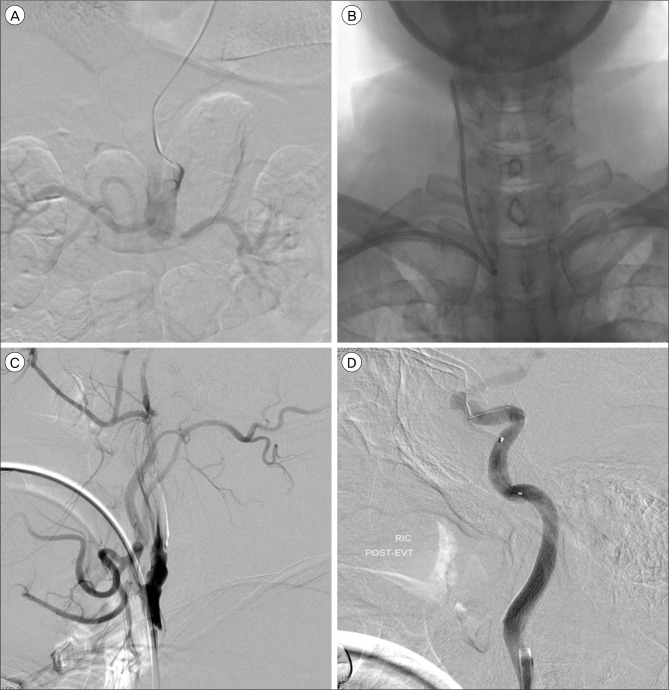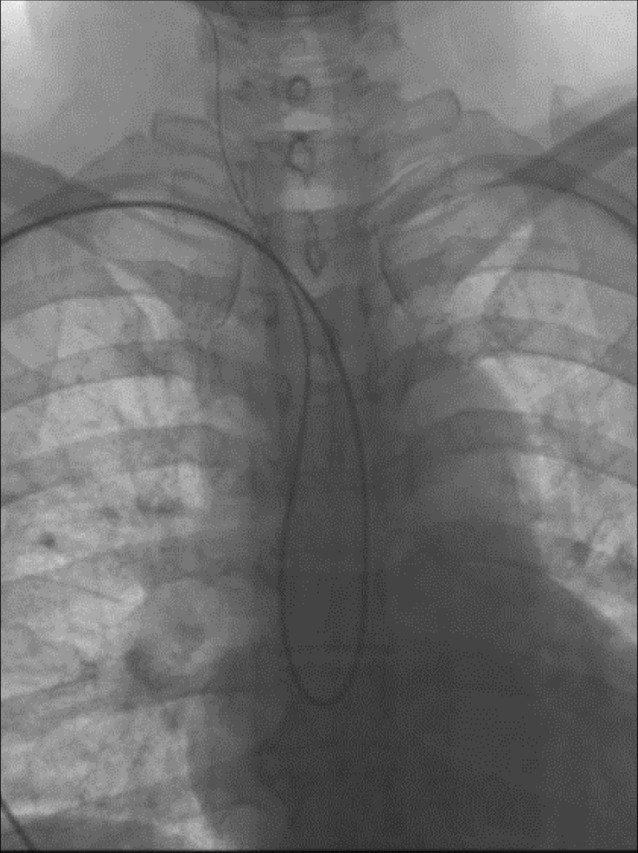J Cerebrovasc Endovasc Neurosurg.
2016 Jun;18(2):129-134. 10.7461/jcen.2016.18.2.129.
Trans-radial Carotid Artery Stenting in a Patient with Abdominal Aortic Occlusion
- Affiliations
-
- 1Department of Neurosurgery, Bucheon St. Mary's Hospital, College of Medicine, The Catholic University of Korea, Bucheon, Korea. twinpapa@catholic.ac.kr
- KMID: 2354889
- DOI: http://doi.org/10.7461/jcen.2016.18.2.129
Abstract
- We report transradial access (TRA) for emergency carotid artery stenting (CAS) as a useful alternative when the femoral artery cannot be accessed. A 63-year-old man arrived at our emergency room 30 minutes after left hemiplegia and loss of consciousness. Brain computed tomography (CT) anigograpy showed occlusion of the right interntal carotid artery (ICA) and CT perfusion revealed delayed time-to-peak in the territory of the middle cerebral artery. For, endovascular treatment, trans-femoral access (TFA) was attempted but failed due to occlusion of the abdominal aorta. So, we changed access route via radial artery and confirmed proximal ICA dissection. CAS was attempted via TRA and it was successfully performed. Final angiography showed recanalization of ICA and patient was clinically improved.
Keyword
MeSH Terms
Figure
Reference
-
1. Ashraf T, Panhwar Z, Habib S, Memon MA, Shamsi F, Arif J. Size of radial and ulnar artery in local population. J Pak Med Assoc. 2010; 10. 60(10):817–819. PMID: 21381609.2. Brott TG, Hobson RW 2nd, Howard G, Roubin GS, Clark WM, Brooks W, et al. Stenting versus endarterectomy for treatment of carotid-artery stenosis. N Engl J Med. 2010; 7. 363(1):11–23. PMID: 20505173.
Article3. Fang CC, Jao YT, Wu CJ. Filter wire fracture during transradial carotid stenting. Int J Cardiol. 2014; 9. 176(2):e66–e69. PMID: 25112545.
Article4. Louvard Y, Lefevre T, Allain A, Morice M. Coronary angiography through the radial or the femoral approach: The CARAFE study. Catheter Cardiovasc Interv. 2001; 2. 52(2):181–187. PMID: 11170325.
Article5. Mann T, Cubeddu G, Bowen J, Schneider JE, Arrowood M, Newman WN, et al. Stenting in acute coronary syndromes: a comparison of radial versus femoral access sites. J Am Coll Cardiol. 1998; 9. 32(3):572–576. PMID: 9741495.
Article6. Pieniazek P, Musialek P, Kablak-Ziembicka A, Tekieli L, Motyl R, Przewlocki T, et al. Carotid artery stenting with patient- and lesion-tailored selection of the neuroprotection system and stent type: early and 5-year results from a prospective academic registry of 535 consecutive procedures (TARGET-CAS). J Endovasc Ther. 2008; 6. 15(3):249–262. PMID: 18540694.
- Full Text Links
- Actions
-
Cited
- CITED
-
- Close
- Share
- Similar articles
-
- Ophthalmic Artery Occlusion After Carotid Revascularization
- Retinal Artery Occlusion after Carotid Angioplasty and Stenting: A Case Report
- A Case of Transseptal Approach to Carotid Artery Stenting in Right Internal Carotid Stenosis
- Y Stent Rendezvous to Treat Symptomatic Innominate Artery Stenosis
- Carotid Artery Stenting in a Patient with Spontaneous Recanalization of a Proximal Internal Carotid Artery Occlusion: a Case Report




